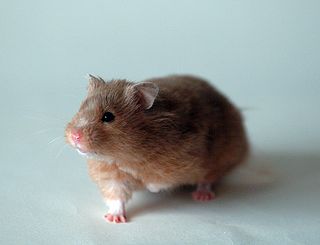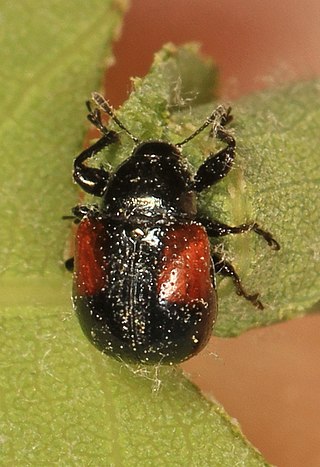
The Curculionidae are a family of weevils, commonly called snout beetles or true weevils. They are one of the largest animal families with 6,800 genera and 83,000 species described worldwide. They are the sister group to the family Brentidae.

Weevils are beetles belonging to the superfamily Curculionoidea, known for their elongated snouts. They are usually small – less than 6 mm in length – and herbivorous. Approximately 97,000 species of weevils are known. They belong to several families, with most of them in the family Curculionidae. It also includes bark beetles, which while morphologically dissimilar to other weevils in lacking the distinctive snout, is a subfamily of Curculionidae. Some other beetles, although not closely related, bear the name "weevil", such as the biscuit weevil, which belongs to the family Ptinidae.

The northern flicker or common flicker is a medium-sized bird of the woodpecker family. It is native to most of North America, parts of Central America, Cuba, and the Cayman Islands, and is one of the few woodpecker species that migrate. Over 100 common names for the northern flicker are known, including yellowhammer, clape, gaffer woodpecker, harry-wicket, heigh-ho, wake-up, walk-up, wick-up, yarrup, and gawker bird. Many of these names derive from attempts to imitate some of its calls. It is the state bird of Alabama.

The golden hamster or Syrian hamster is a rodent belonging to the hamster subfamily, Cricetinae. Their natural geographical range is in an arid region of northern Syria and southern Turkey. Their numbers have been declining in the wild due to a loss of habitat from agriculture and deliberate elimination by humans. Thus, wild golden hamsters are now considered endangered by the International Union for Conservation of Nature. However, captive breeding programs are well established, and captive-bred golden hamsters are often kept as small house pets. They are also used as scientific research animals.

The green-and-black poison dart frog, also known as the green-and-black poison arrow frog and green poison frog, is a brightly-colored member of the order Anura native to southern Central America and Colombia. This species has also been introduced to Oahu, Hawaii in an effort to lower mosquito numbers. It is one of the most variably colored species of poison dart frogs, after D. tinctorius, Adelphobates galactonotus and some Oophaga species. From a conservation standpoint, it is considered to be of least concern by the International Union for Conservation of Nature. Within the reptile and amphibian hobby, D. auratus remains one of the most commonly kept, and easiest-to-breed, dart frogs in captivity, as well as in zoos.

The East Javan langur, also known as the ebony lutung, Javan langur or Javan lutung, is an Old World monkey from the Colobinae subfamily. It is most commonly glossy black with a brownish tinge to its legs, sides, and "sideburns". It is found on the island of Java, as well as on several of the surrounding Indonesian islands. The Latin word auratus in its scientific name means "golden", and refers to a less common color variant. Note that the common name golden langur is used for a different species.

The Australasian snapper or silver seabream is a species of porgie found in coastal waters of Australia, Philippines, Indonesia, mainland China, Taiwan, Japan and New Zealand. Its distribution areas in the Northern and Southern Hemispheres are disjunct. Although it is almost universally known in Australia and New Zealand as snapper, it does not belong to the Lutjanidae snapper family. It is highly prized as an edible fish, with a sweet sea taste and a firm texture.

Brentidae, sometimes known as the primitive weevils, is a cosmopolitan family of primarily xylophagous beetles also known as straight-snouted weevils. The concept of this family has been expanded with the inclusion of three groups formerly placed in the Curculionidae; the subfamilies Apioninae, Cyladinae, and Nanophyinae, as well as the Ithycerinae, previously considered a separate family. They are most diverse in the tropics, but occur throughout the temperate regions of the world. They are among the families of weevils that have non-elbowed antennae, and tend to be elongate and flattened, though there are numerous exceptions.
The Indochinese black langur is a poorly known Old World monkey native to Laos and adjacent Vietnam. It was originally described as a subspecies of T. auratus, but was later found to be a member of the T. francoisi group, with some maintaining it as a subspecies of that species. In 2001, it was recommended treating it as a separate species.
In the 10th edition of Systema Naturae of 1758–1759, Carl Linnaeus classified the arthropods, including insects, arachnids and crustaceans, among his class "Insecta". He described the Insecta as:
A very numerous and various class consisting of small animals, breathing through lateral spiracles, armed on all sides with a bony skin, or covered with hair; furnished with many feet, and moveable antennae, which project from the head, and are the probable instruments of sensation.
In the 10th edition of Systema Naturae, Carl Linnaeus classified the arthropods, including insects, arachnids and crustaceans, among his class "Insecta". Insects with hardened wing covers were brought together under the name Coleoptera.

Apoderus coryli, the hazel-leaf roller weevil, is a species of leaf-rolling beetles belonging to the family Attelabidae subfamily Attelabinae. Because of the trunk-like elongated head, it is often mistakenly attributed to the weevil family Curculionidae.

Attelabus is a genus of weevils belonging to the family Attelabidae.

Lignyodes is a genus of ash seed weevils in the family Curculionidae. There are at least 18 described species in Lignyodes.

Rhynchites auratus, sometimes called the apricot weevil, cherry-fruit weevil, or golden green snout weevil, is a species of weevil of the family Rhynchitidae.

Attelabinae is a subfamily of leaf-rolling weevils in the beetle family Attelabidae. There are at least 20 genera and more than 690 described species in Attelabinae.
Lignyodes auratus is a species of leguminous seed weevil in the beetle family Curculionidae. It is found in North America.

Rhynchites is a genus of leaf and bud weevils in the family of beetles known as Attelabidae.
Cyvirus cyprinidallo2, also known as Cyprinid herpesvirus 2 (CyHV-2) is a species of virus in the genus Cyprinivirus, family Alloherpesviridae, and order Herpesvirales.
Henri Jekel was a French coleopterist.













